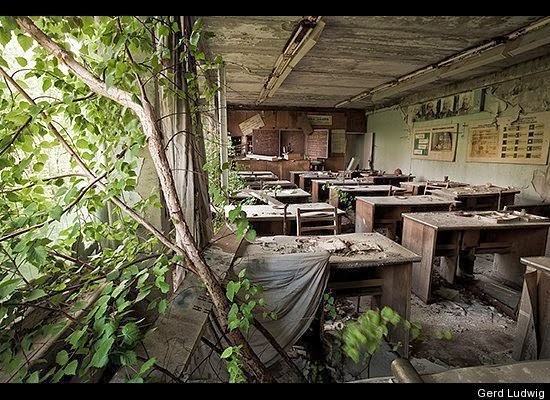Bryansk: the aftermath of Chernobyl
 |
| Map of Chernobyl |
Background:
-Nuclear power plant located in Ukraine
-Included four pressurized water reactors
-Provided 10% of energy used in Ukraine
-Construction of plant began in 1970's
 |
| Chernobyl Power Plant 2 days after explosion |
The Explosion:
-Explosion occurred on April 26, 1968
-Human error shutting down reactor
-50 tons of nuclear fuel injected into atmosphere
-Sand and boron poured on reactor to try and stop radioactive release
]
The Fallout:
-Bryansk Region in Russia received the highest level of radioactive fallout -Evacuations began within twelve hours
-Evacuations began within twelve hours-Incidences of thyroid cancer, leukemia, and other radiation-related illnesses
-Fallout polluted ecosystems and human food sources
Environmental Impacts:
-Radioisotopes absorbed by plants
-About 40% of all pine trees died
within eight years
-Mutations in DNA of wheat
-Radiation accumulates in food chains
-Mutations common in animals and humans
-Relocation of Ukrainian citizens allowed ecosystems to flourish
-Relocation of Ukrainian citizens allowed ecosystems to flourish
Ethical Concerns:
-By not informing the population, thousands were exposed to radiation without knowing it
-People were not able to react as quickly to the nuclear explosion
-Chernobyl did not have the containment
structure common to most nuclear power plants
-The explosion could have been avoided if not for flawed reactor design and human carelessness
 |
| An abandoned schoolroom twenty five years after the reactor explosion |
Discussion Questions:
- Based off what we know about the disaster of Chernobyl, how do
you think Nuclear Energy should be viewed in the 21st century?
- Some people argue that engineers have learned safer ways of constructing nuclear facilities. Does this justify the continuation of nuclear power plants?
- The USA is the world's largest producer of nuclear power, accounting for more than 30% of worldwide nuclear generation of electricity.
- If our country is so reliant on nuclear power
plants for a source of energy, does this justify our reliance on other fossil
fuels such as oil and gas, which are less dangerous to obtain?
- Some people argue that engineers have learned safer ways of constructing nuclear facilities. Does this justify the continuation of nuclear power plants?
- If our country is so reliant on nuclear power plants for a source of energy, does this justify our reliance on other fossil fuels such as oil and gas, which are less dangerous to obtain?
Work Cited:
"Backgrounder on Chernobyl Nuclear Power
Plant Accident." United States Nuclear Regulatory Commission.
USA.gov, n.d. Web. 22 Sept. 2013. <http://www.nrc.gov/reading-rm/doc-collections/fact-sheets/chernobyl-bg.html>.
"Chernobyl Accident and Its
Consequences." Nuclear Energy Institute. N.p., n.d. Web. 26 Sept.
2013. <http://www.nei.org/Master-Document-Folder/Backgrounders/Fact-Sheets/Chernobyl-Accident-and-Its-Consequences>.
"Chernobyl Accident 1986." World
Nuclear Association. World Nuclear News, n.d. Web. 25 Sept. 2013. <http://www.world-nuclear.org/info/Safety-and-Security/Safety-of-Plants/Chernobyl-Accident/>.
Flanary, W. (2013). Environmental
effects of the Chernobyl accident. Retrieved from http://www.eoearth.org/view/article/152617
"How does Fukushima differ from
Chernobyl?" BBC News. N.p., 16 Dec. 2011. Web. 25 Sept. 2013. <http://www.bbc.co.uk/news/world-asia-pacific-13050228>.
"Pros and Cons of Nuclear Power." Discovery.
Discovery Communications, n.d. Web. 27 Sept. 2013. <http://dsc.discovery.com/tv-shows/curiosity/topics/10-pros-cons-nuclear-power.htm>.


No comments:
Post a Comment